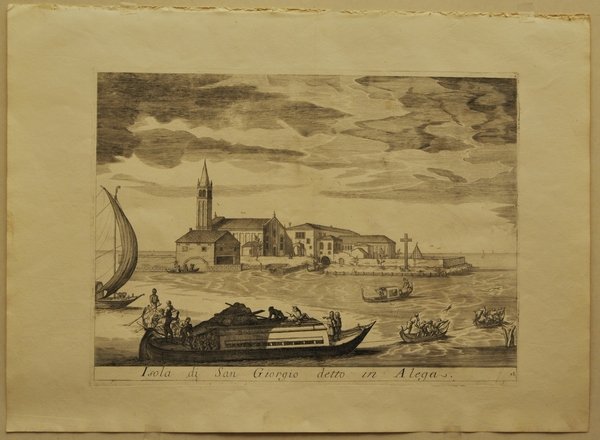Details
Publisher
Venezia: Domenico Lovisa, 1720.
Engravers
Lovisa Domenico
Description
Acquaforte e bulino di 467 x 340 mm. Carta pastosa, spessa, fittamente vergata. Filigrana 2 esse. Stato I/I. Pieni margini . Foglio in perfetto stato di conservazione. "Isola di S. Giorgio detto in Alega" al centro in basso, "Per Domenico Lovisa in Rialto Venetia" a destra in basso. Proveniente da: "Il Gran Teatro delle Pitture e Prospettive di Venezia, in due tomi diviso". Il foglio, che rappresenta una delle Isole ancora esistenti, sebbene molto diverse, della Laguna, fa parte della grande opera di Domenico Lovisa, pubblicata a Venezia nel 1720. La suite si componeva di due volumi: il primo, relativo a vedute veneziane e lagunari, venne disegnato da Giuseppe Valeriani, mentre è ignoto chi ne fu l'incisore; il secondo, relativo a pitture di celebri artisti veneziani, venne realizzato da Andrea Zucchi. L'album di vedute, sebbene non eccelso da un punto di vista stilistico, rappresenta la più ampia documentazione sulla vita privata a Venezia nel 1700: la scena è sempre ricolma di azione, spesso anche spiritosa, tutta tesa ad una rappresentazione cronachistica, più che architettonica, di Venezia. Cicogna 4541, Succi 230. (EN) Etching and burin measuring 467 x 340 mm. Pasty, thick, thickly laid paper. Watermark 2 Ss. State I/I. Full margins. Sheet in perfect condition. "Island of S. Giorgio known as in Alega" at the bottom center, "Per Domenico Lovisa in Rialto Venetia" at the bottom right. Coming from: "The Grand Theater of Paintings and Perspectives of Venice, divided into two volumes". The sheet, which represents one of the still existing, although very different, islands of the lagoon, is part of the great work by Domenico Lovisa, published in Venice in 1720. The suite was made up of two volumes: the first, relating to Venetian and lagoon views , was designed by Giuseppe Valeriani, while it is unknown who was the engraver; the second, relating to paintings by famous Venetian artists, was created by Andrea Zucchi. The album of views, although not excellent from a stylistic point of view, represents the most extensive documentation on private life in Venice in 1700: the scene is always full of action, often even witty, all aimed at a chronicle representation, rather than architectural, of Venice. Cicogna 4541, Succi 230.


Find out how to use
Find out how to use

